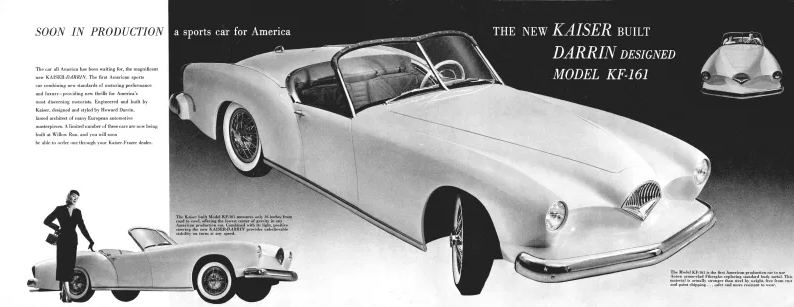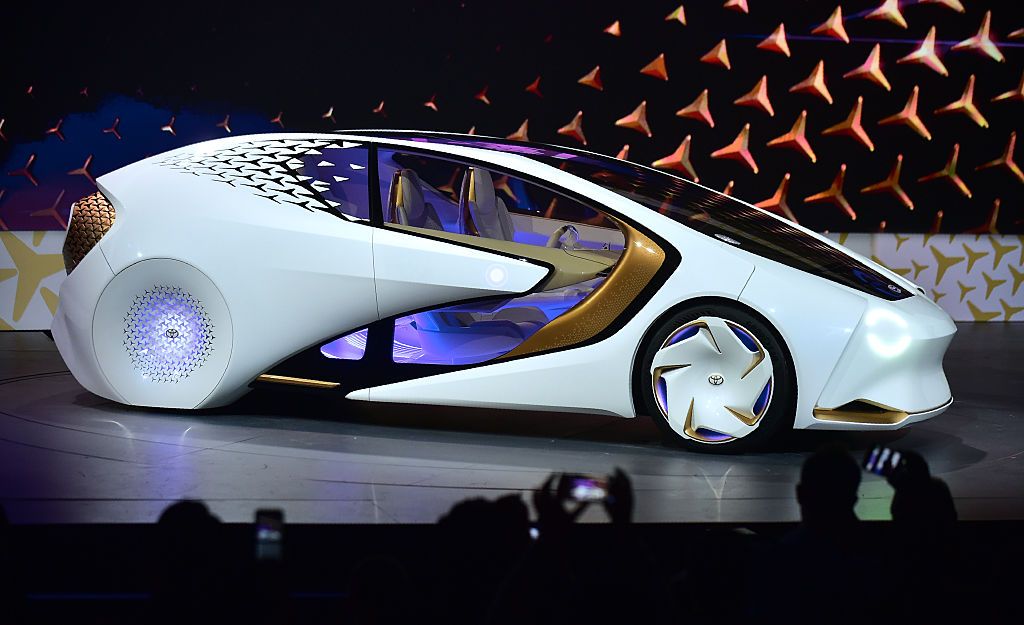As the 1940s were drawing to a close Americans were becoming sports car conscious, thanks to the affordable MG TCs being imported from England. By the early 1950s, buyers might choose from the MG TD, Triumph TR2, Austin-Healey 100, Jaguar XK120 and others.
Seeing a growing market, some American companies developed and marketed what they called sports cars. These usually were sporty cars with sports car looks, but lacking in sports car characteristics such as good handling. They sold in low, sometimes hardly detectable, volumes, so their bodies were often made of fiberglass to save production costs. I wrote about some of them here. As it turned out, the only market success was the Chevrolet Corvette that remains in production more than 60 years later.
For this post, I deal in more detail with the 1954 Kaiser Darrin. Its Wikipedia entry is here, and another fairly lengthy treatment is here.
I stand by the assessment I make in the post linked above, where I stated:
"Kaiser was on its way out as a mainstream manufacturer, so the Kaiser Darrin can be seen as one of the company's last-ditch dice rolls. Darrin himself had been involved in custom coachbuilding for many years (think Hibbard & Darrin of Paris, late 1920s) and had been a styling consultant to Kaiser. The fiberglass-bodied Kaiser Darrin sat on a Henry J (compact Kaiser line) chassis and also hewed to the prevailing sports car fashion -- but with several distinctive twists. Most obvious is the tiny grille that makes me wonder if the radiator was given as much cool air as it needed. Then there are the sliding doors that, according to the [Wikipedia] link, proved troublesome. The back fenders had a falling-to-the-rear shape that terminated in standard Kaiser sedan tail lights."
Here is designer Dutch Darrin with the 1953 prototype. Note the divided windshield with rounded top segments, a feature on Kaiser sedans.
Publicity card announcing the Kaiser Darrin. The prototype is shown, Click to enlarge if you want to try reading the text (it'll still be very small).
This photo shows an event where the prototype is on display.
Publicity photo of a production Kaiser Darrin. The windshield is now a one-piece affair. This image and the one above illustrate how cramped Darrin's beloved sliding door openings were.
Auction photo (RM Sotheby's) showing the front and the small grille. More air must have entered from below the bumper.
Side view of a Bonhams auction item. The leading edge of the rear fender is aligned with the door cut line and seating. This made production sense due to the sliding nature of the doors as well as probably simplifying the fiberglass moulds. However, the resulting fender shape does not relate well to the rear wheel and its opening.
Same car, rear 3/4 view. The trunk seems tiny, especially given that it would be the location of the spare tire. Apparently Kaiser Darrins were intended for day trips, not long journeys. The tail lights are those of 1952-53 Kaiser sedans.
As the 1940s were drawing to a close Americans were becoming sports car conscious, thanks to the affordable MG TCs being imported from England. By the early 1950s, buyers might choose from the MG TD, Triumph TR2, Austin-Healey 100, Jaguar XK120 and others.
Seeing a growing market, some American companies developed and marketed what they called sports cars. These usually were sporty cars with sports car looks, but lacking in sports car characteristics such as good handling. They sold in low, sometimes hardly detectable, volumes, so their bodies were often made of fiberglass to save production costs. I wrote about some of them here. As it turned out, the only market success was the Chevrolet Corvette that remains in production more than 60 years later.
For this post, I deal in more detail with the 1954 Kaiser Darrin. Its Wikipedia entry is here, and another fairly lengthy treatment is here.
I stand by the assessment I make in the post linked above, where I stated:
"Kaiser was on its way out as a mainstream manufacturer, so the Kaiser Darrin can be seen as one of the company's last-ditch dice rolls. Darrin himself had been involved in custom coachbuilding for many years (think Hibbard & Darrin of Paris, late 1920s) and had been a styling consultant to Kaiser. The fiberglass-bodied Kaiser Darrin sat on a Henry J (compact Kaiser line) chassis and also hewed to the prevailing sports car fashion -- but with several distinctive twists. Most obvious is the tiny grille that makes me wonder if the radiator was given as much cool air as it needed. Then there are the sliding doors that, according to the [Wikipedia] link, proved troublesome. The back fenders had a falling-to-the-rear shape that terminated in standard Kaiser sedan tail lights."
Here is designer Dutch Darrin with the 1953 prototype. Note the divided windshield with rounded top segments, a feature on Kaiser sedans.
Publicity card announcing the Kaiser Darrin. The prototype is shown, Click to enlarge if you want to try reading the text (it'll still be very small).
This photo shows an event where the prototype is on display.
Publicity photo of a production Kaiser Darrin. The windshield is now a one-piece affair. This image and the one above illustrate how cramped Darrin's beloved sliding door openings were.
Auction photo (RM Sotheby's) showing the front and the small grille. More air must have entered from below the bumper.
Side view of a Bonhams auction item. The leading edge of the rear fender is aligned with the door cut line and seating. This made production sense due to the sliding nature of the doors as well as probably simplifying the fiberglass moulds. However, the resulting fender shape does not relate well to the rear wheel and its opening.
Same car, rear 3/4 view. The trunk seems tiny, especially given that it would be the location of the spare tire. Apparently Kaiser Darrins were intended for day trips, not long journeys. The tail lights are those of 1952-53 Kaiser sedans.



















EmoticonEmoticon